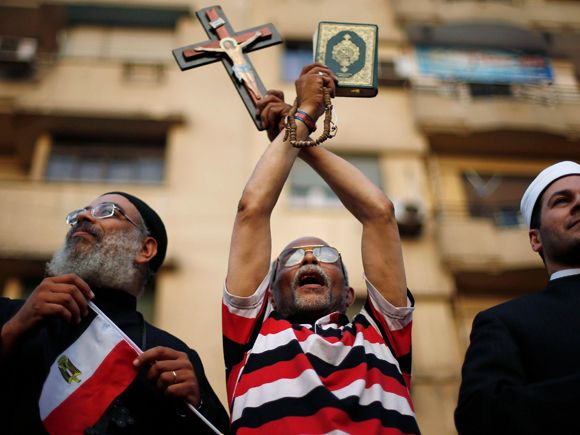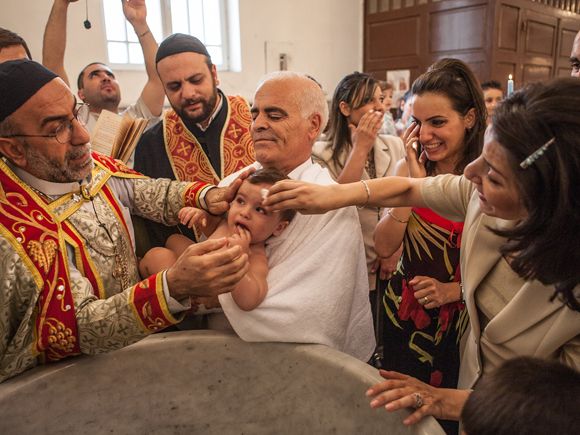During the lifetime of the Prophet Mohammed in the 7th century, Middle Eastern countries like Egypt and Syria had large Christian majorities. Four centuries later, the first Crusade was fought in a land that, even though it was under Islamic rule, was probably still mostly Christian. Yet the Christian population of the Middle East has experienced a steady decline which has been especially steep in the past century, and the last decade most of all.
The reasons for this are a complex mixture of discrimination and persecution on the one hand, and emigration to Europe and the United States on the other. Janine di Giovanni’s primary purpose in her new book The Vanishing is to record the histories of a community that may not last another century. Writing as a practising Catholic, she evokes the importance of faith for providing a sense of belonging to a land made holy by the accretion of stories from the Bible and the lives of the saints—as well as by the everyday memories of Christian families themselves.
This is an interesting work of journalism that mixes personal reflection with a patchwork of reportage. The book charts how recent political events have affected the region’s Christians. In Iraq, Saddam’s surveillance state gave way to outright persecution by the Islamic State (IS). The targeting of Christians might have been encouraged by American refugee policy, which excluded Arab Muslims but allowed in Arab Christians, who then came to be associated with the US and Zionism. In Gaza City, di Giovanni describes a place of thwarted hope, where Gazans are caught between the Israel-Palestine conflict and the intra-Palestinian struggle of Fatah and Hamas. Christian Gazans are particularly vulnerable under Hamas rule: their bookshops have been firebombed and women harassed for refusing to wear the veil.
Syria has, perhaps, fared worst of all during a devastating 10-year civil war. The hope of Syrian Christians—that stability would be swiftly restored—has been thwarted, and now many have emigrated. Those who remain often support the Assad government as a reliable source of authority, and lay the blame for the rebellion on outside powers (Turkey, the Gulf States and the US), whose money has ended up funding Islamist extremists. Syrian Christians once played a major role in the creation of Arab nationalism, but there has long been distrust between confessional communities. The chants heard in 1970s Aleppo, “poor Armenians, we’ll put them to the knife,” raised the spectre of the genocide at the start of the 20th century, and served as a form of intimidation of the Christian minority.
In Egypt, religious differences are compounded by the impoverished conditions of Christians who live in rural areas like Minya, or those who work as Zabbaleen (refuse-collectors) on the streets of Cairo. Christians often rely on the state to protect religious buildings. They have little choice: on Palm Sunday in 2017, a suicide bomb attack on Saint Mark’s Coptic Orthodox Cathedral in Alexandria killed 17 people; a further church attack on the same day in Tanta killed 30. Systems of arbitration and local justice are often skewed against Christians; as in Gaza, Christian women are harassed in the street for refusing to wear veils and Christian men who marry Muslim women are expressly targeted. Obviously, wealth can ameliorate many of these restrictions; but even a wealthy Christian could never hope to become president or enter the higher echelons of the military.
“Christian Gazans are particularly vulnerable: their bookshops have been firebombed and women harassed for refusing to wear them”
At an emotional level, di Giovanni’s account can provoke anger and sadness. It shows us what it means to be stripped of a home and its traditions, and of what is lost by emigration and assimilation. The book is clear that Christians often suffer the same injustices as their Muslim neighbours, but that this is sometimes made worse by further discrimination. They are seen almost as foreigners in their own land, as Jewish communities were across the Middle East after Israel was established in 1948. But is di Giovanni right to represent Middle Eastern Christianity as merely a history of long decline, to be inevitably followed by extinction?
Much of the history of Christians (and Jews) in the region can be viewed in lachrymose terms: a series of persecutions against a backdrop of constant discrimination. Di Giovanni gives one account of an Iraqi priest who spoke in these terms in 2003—terms that seem almost prophetic given the rise of IS and the sectarianisation of Iraqi politics. But it is worth reflecting that this kind of history serves a distinct purpose: when it is retold in the Middle East, it re-enforces the impression that Christians’ best interests are served when they reserve their loyalties for the Christian community and its leaders, rather than the wider state. As in Syria and Egypt, it can also lead to support for an authoritarian political leader who promises to protect them.
However, there are other stories we might tell that could provide models for a more pluralistic Middle East. For instance, the late 19th century witnessed a number of constitutional experiments in the Ottoman Empire that removed legal obstacles from Christians and Jews. In a departure from medieval Islamic law, religious minorities were no longer subject to greater taxation or different rights as legal witnesses and they acquired the right to bear arms and the obligation of military service. These experiments did not ultimately bear fruit: the ideal of equality for all Ottomans struggled with the opposing idea of pan-Islamism. And in the context of military humiliation by European states, many Muslims were not prepared to concede equal rights to their Christian neighbours. The issue became a flashpoint for political violence.

Another moment we should remember is the co-operation of Muslims and Christians during Egypt’s democratic experiments in the 1920s and 1930s. These years were dominated by protests against the British presence in Egypt and its monarchy, and they were also marked by the rise of political parties that cut across religious divides. The Wafd party, founded in 1923, used the cross and crescent together as a symbol of a united Egypt, where “religion is for God and the nation is for all.” This was the first party to elect Coptic Christians to major positions. This is not to endorse the modern Wafd party as a cure for Egypt’s many problems, but simply to point out that Egypt has a home-grown tradition of pluralism that does not need to be imported from elsewhere. Something of this spirit of inter-religious co-operation was invoked in the events of Tahrir Square in 2011, when Christian protesters formed a ring around praying Muslims.
“The focus on Christian suffering needs to be accompanied by a deeper examination of those who discriminate or persecute”
Di Giovanni’s informants give a negative account of the future of Christianity in the region and there is good reason for their pessimism. But we might also reflect that the clerical leadership of many Christian communities fear the pluralism of movements like the Wafd. When I lived in a monastery in Syria, the same priests who argued in favour of the regime were also deeply socially conservative. One man I knew claimed Costa Coffee was corrupting the youth. My point is that a distrust of outside influences could be justified in terms of the need to preserve the faith against Muslim aggression—but it also helped to justify the clerical leadership.
Two kinds of intervention might alter the position of Christians in the Middle East for the better. The first is a change in foreign policy. Islamism has only been an attractive force in the region since the late 1970s, when both liberalism and socialism seemed to have become contaminated by the behaviour of both the US and the Soviets. This disenchantment has only increased in subsequent decades, when the rhetoric of liberalism has often seemed like an empty shell. In particular, both Britain and the US have supported a Saudi regime that utterly flouts liberal principles and drives global funding for highly conservative Islamist projects. Large numbers of Saudi-funded mosques have been built in Syria in the last decade, in spite of the war. Islamism has flourished for want of other ways to challenge corrupt, authoritarian societies. But it is a process that can be reversed if we in the west can wean ourselves off trade in arms and oil, a process that would benefit the region’s minorities.
The second area is education. There has been much discussion of the imperial legacies of Europe and North America, regarding the treatment of indigenous populations during colonialism or the slave trade. Though such issues are far from resolved, the self-critique of European colonialism has no analogue in the Middle East: there is little sense in curricula or television dramas that the Arab conquests of the 7th century or the Ottomans in the 15th are anything other than glorious achievements, or even proofs of the truth of Islam. From this can flow a notion that Christians are inherently inferior to Muslims, a remnant of a defeated people whose religion has been superseded by Islam.
Of course, not everyone will draw these conclusions, but they are readily available in Arabic for those who seek them out. When I lived in Syria, I saw that you could buy garishly illustrated pictures of the early Muslims slaughtering Christian Romans; I find it striking that di Giovanni describes Christians being called “Romans” as a term of abuse.

If a government wanted to establish a sense of Arab nationhood that transcended religion, then a good place to start would be a self-critical examination of the histories of all communities. This would be a major challenge, and one that Europe and North America have only just begun to grapple with. But we cannot assume that the Middle East is automatically incapable of this kind of pluralism or that tradition ultimately determines people’s loyalties and that the appearance of modernity is just a veneer. To do so would be just another form of colonial paternalism.
Di Giovanni is certainly correct to point to the attraction of tradition and the anguish of emigration. But one of the dangers of relying as she does on a series of snapshots is that we lose the sense of change over time, as well as the wider context for changes in behaviour. In particular, the focus on Christian suffering needs to be accompanied by a deeper examination of those who discriminate or persecute, and what prompts these behaviours to intensify or abate.












